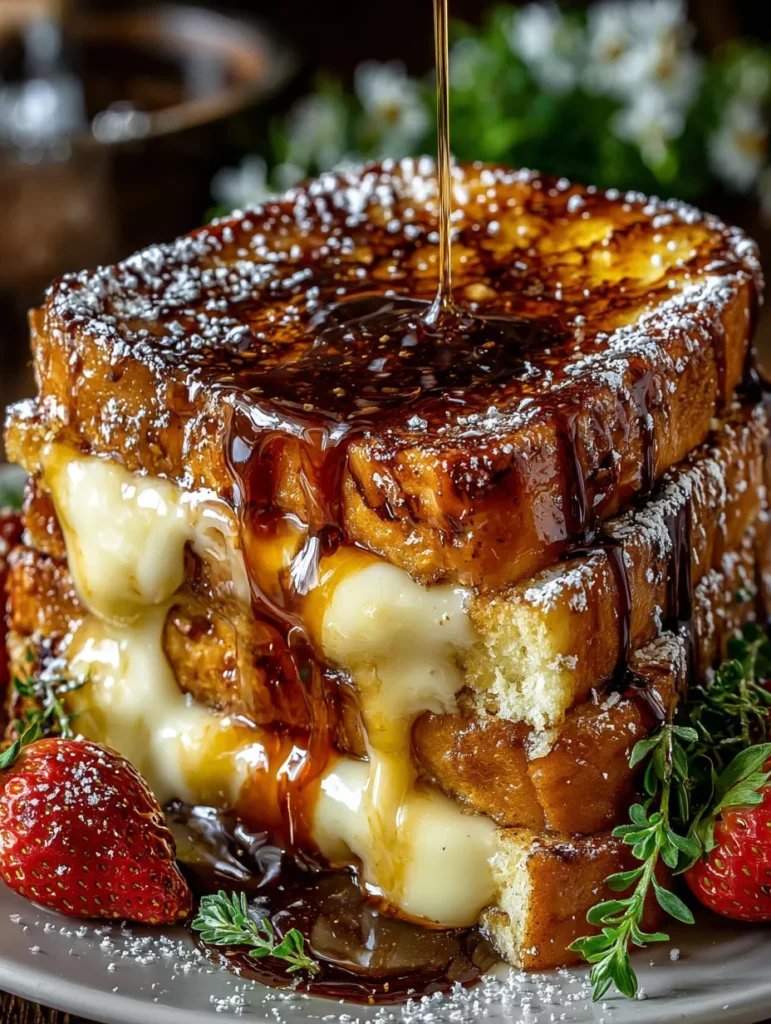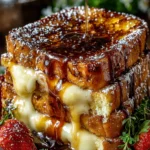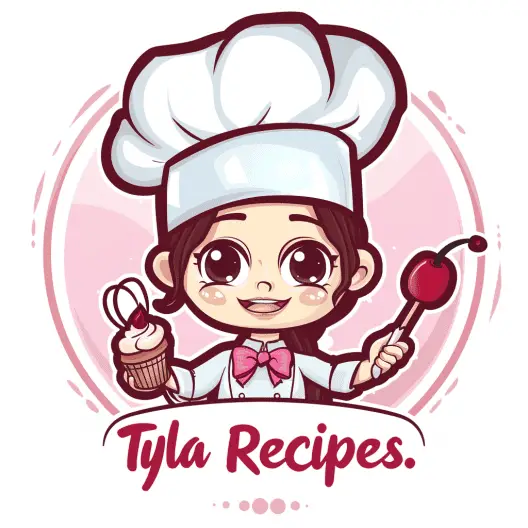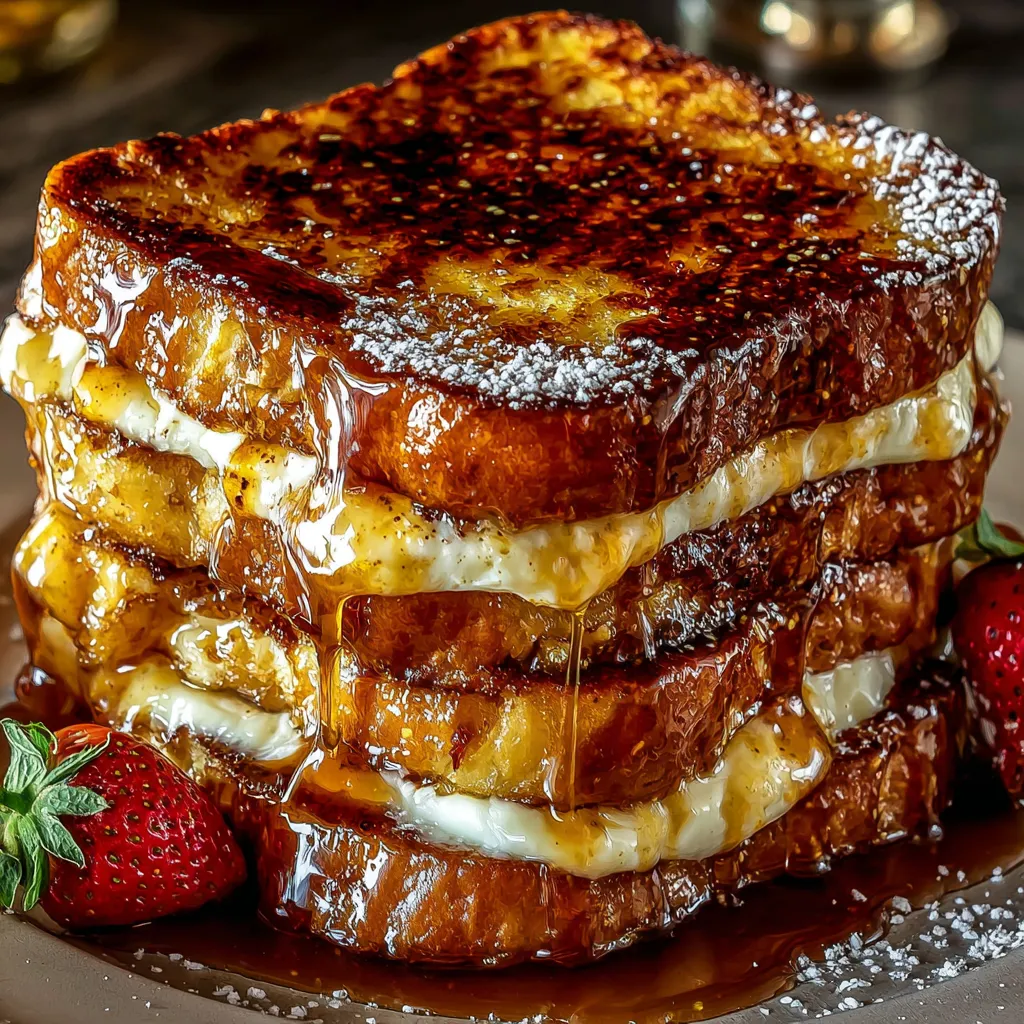Okay, so someone looked at regular French toast—which is already peak breakfast—and said “you know what this needs? A BLOWTORCH.” And thus, this absolute legend of a breakfast was born. Crème Brûlée French Toast is what happens when fancy French dessert and classic American breakfast have a love child that’s too good for regular maple syrup. We’re talking thick-cut brioche soaked in a custard so rich it should pay taxes, then topped with a layer of sugar that you literally set on fire to create that signature crackling, caramelized shell. It’s the kind of breakfast that makes you feel like you should be wearing a fancy robe and reading the newspaper on a veranda, even if you’re actually eating it in your pajamas over the kitchen sink. I made this for brunch once and someone proposed to me. I’m not even exaggerating. Another friend accused me of “ruining regular French toast forever.” These are the risks we take.
Why You’ll Love This Recipe
Fancy without the fuss. Looks like something from a five-star brunch spot. Actually pretty easy to make.
That dramatic torch moment. Using a kitchen torch makes you feel like a professional chef, even if you’re absolutely not.
The CRACKLE. Breaking through that caramelized sugar shell with your fork is deeply satisfying on a spiritual level.
Rich and decadent. This isn’t your average diner French toast. This is an EXPERIENCE.
Make-ahead friendly. Soak the bread overnight and torch right before serving for minimal morning effort.
Brunch flex. Serve this and everyone thinks you went to culinary school. Let them believe it.

The Good Stuff You’ll Need
For the Custard Base:
- 6 large eggs
- 1 1/2 cups heavy cream
- 1/2 cup whole milk
- 1/3 cup granulated sugar
- 2 tsp vanilla extract
- 1/4 tsp ground cinnamon (optional, but adds warmth)
- Pinch of salt
- Zest of 1 orange (optional but HIGHLY recommended for that fancy factor)
For the Toast:
- 1 loaf brioche bread, cut into 1-inch thick slices (8 slices)
- You can also use challah or thick Texas toast if brioche isn’t available
- DO NOT use regular sandwich bread—you need something substantial that won’t disintegrate
For the Brûlée Topping:
- 1/2 to 3/4 cup granulated sugar (for torching)
- The exact amount depends on how many slices you’re making
For Cooking:
- 2-3 tbsp butter (for the pan)
Equipment You Actually Need:
- Kitchen torch (this is non-negotiable—you NEED the torch for the authentic experience)
- Large shallow dish for soaking (a 9×13 baking dish works perfectly)
- Large skillet or griddle
- Spatula
Let’s Do This
Step 1: Make That Custard
In a large bowl or shallow baking dish, whisk together eggs, heavy cream, milk, sugar, vanilla, cinnamon, salt, and orange zest if using.
Whisk it REALLY well. You want the eggs completely incorporated—no eggy chunks floating around. This custard should be smooth and luxurious.
Taste it (yes, taste the raw egg mixture—we’re living dangerously). It should be sweet and vanilla-forward with a hint of richness.
Step 2: Soak the Bread
Arrange your thick brioche slices in the custard mixture in a single layer.
Let them soak for at least 3-4 minutes per side. These thick boys need time to absorb all that custardy goodness.
Press down gently with a spatula to help the custard penetrate. You want the bread saturated but not falling apart.
Make-Ahead Option: Cover and refrigerate overnight for the ultimate custard absorption. The bread will be INCREDIBLY rich and custardy. This is actually the preferred method if you have time.
Step 3: Cook the French Toast
Heat a large skillet or griddle over medium heat. Add a tablespoon of butter and let it melt, coating the pan.
Carefully transfer soaked bread slices to the hot pan. Don’t overcrowd—work in batches.
Cook for 3-4 minutes per side until golden brown and slightly crispy on the edges. You want that beautiful caramelization happening.
The inside should be custard-set and cooked through but still creamy. If it’s browning too fast, lower the heat.
Transfer cooked slices to a baking sheet and keep warm in a 200°F oven while you finish the rest.
Step 4: The Brûlée Magic (This Is Where It Gets Real)
Arrange your cooked French toast on serving plates or a large platter.
Sprinkle a generous, EVEN layer of granulated sugar over the top of each slice. Like, really coat it. You want about 1-2 tablespoons per slice.
Get your kitchen torch. Turn it on. Feel powerful.
Hold the torch 3-4 inches away from the sugar and move it in a circular motion. Watch the magic happen as the sugar melts, bubbles, and turns that gorgeous amber color.
Keep torching until you have a deep golden-brown caramelized shell. Don’t rush this—you want it properly caramelized, not just melted.
Let the sugar cool and harden for about 1 minute. It should form that signature crispy shell that cracks when you tap it.
Step 5: Serve Immediately
Top with fresh berries if you want to pretend this is healthy.
A light dusting of powdered sugar adds extra elegance.
Serve with warm maple syrup on the side (though honestly, the caramelized sugar topping IS the topping).
Maybe add a dollop of whipped cream or crème fraîche for extra decadence.
Watch as people’s minds are blown.
Serving Suggestions
These are already extra, but if you want to go FULL extra:
- Serve with fresh berries (strawberries, raspberries, blueberries) and a mint sprig
- Add a side of crispy bacon for sweet-savory balance
- Drizzle with warm berry compote
- Top with mascarpone cream or whipped cream
- Serve with fresh whipped cream infused with vanilla bean
- Pair with mimosas or strong coffee for peak brunch vibes
- Arrange on individual plates with a dusting of powdered sugar for restaurant presentation
Switch It Up
Chocolate Lover’s Brûlée Toast: Add 2 tbsp cocoa powder to the custard and sprinkle chocolate chips between the bread layers.
Stuffed Brûlée Toast: Make a cream cheese filling (8 oz cream cheese + 1/4 cup sugar + 1 tsp vanilla), spread between two slices, press together, dip in custard, and cook as one thick piece.
Banana Foster Style: Cook sliced bananas in butter, brown sugar, and a splash of rum, then top the brûléed toast with this sauce.
Berry Stuffed: Add fresh berries between two slices before soaking for built-in fruit filling.
Almond Crunch: Add 1/2 tsp almond extract to the custard and sprinkle sliced almonds on top before torching.
Eggnog Version: Replace some of the cream with eggnog during the holidays and add extra nutmeg.
Lemon Lavender: Add lemon zest and a tiny pinch of culinary lavender to the custard for a fancy spring brunch.
Storage and Make-Ahead Tips
The beauty of this recipe is you can prep it ahead and just torch at the last minute.
Prep ahead: Soak the bread in custard and refrigerate overnight. Cook in the morning, then torch right before serving.
Cooked toast: Store cooked (but not torched) French toast in the fridge for up to 2 days. Reheat in a 350°F oven for 5-7 minutes, THEN torch.
Freezing: Freeze cooked French toast slices separated by parchment paper for up to 2 months. Reheat from frozen in the oven, then torch.
Never torch in advance. The caramelized sugar shell gets weird and soggy if it sits. Always torch right before serving.
Leftover custard: Use it to make regular French toast or bake it into a bread pudding. Waste not.
Why This Works So Damn Well
The magic of Crème Brûlée French Toast is all about contrasts and technique.
Thick bread is crucial. Thin bread gets soggy and falls apart. Thick-cut brioche or challah has enough structure to absorb tons of custard while still holding together. The richness of brioche also mimics the richness of actual crème brûlée.
The custard ratio matters. Using heavy cream instead of all milk creates that silky, rich texture that’s more custard than egg wash. This isn’t just coating the bread—it’s TRANSFORMING it.
Low and slow cooking ensures the custard sets properly without burning the outside. You’re essentially cooking a custard that happens to have bread in it.
The torch creates real caramelization. You can’t replicate this effect with a broiler (though we’ll talk about that below). The direct, intense heat from the torch caramelizes the sugar rapidly, creating those complex flavors and that crispy shell without overcooking the toast underneath.
Sugar choice matters. Granulated white sugar melts evenly and caramelizes beautifully. Brown sugar or powdered sugar won’t give you the same crispy shell.
The orange zest (if you use it) adds a subtle brightness that cuts through all that richness and makes it taste more sophisticated and dessert-like.
When to Make This
Special Occasion Brunch: Mother’s Day, Easter, Christmas morning—this is THAT breakfast.
Anniversary Breakfast: Romance in carb form. Way better than restaurant brunch.
Showing Off: First time hosting brunch? Make this. Everyone will be impressed.
Weekend Luxury: Because sometimes Saturday morning deserves to be fancy.
Birthday Breakfast: Skip the cake, torch the toast.
Proposal Breakfast: If you’re planning to pop the question over breakfast, this is your dish. (Results may vary.)
Questions People Actually Ask
Q: I don’t have a kitchen torch. Can I use the broiler? A: You CAN, but it’s not the same. Set your broiler to high, sprinkle the sugar on your cooked toast, and broil for 30-60 seconds while watching like a hawk. It won’t be quite as dramatic or evenly caramelized, but it’ll still be delicious.
Q: My sugar is burning in spots but not melting everywhere. Help! A: Keep the torch moving constantly and hold it a bit further away. You might need to add a touch more sugar if you’ve burned through it in spots.
Q: The bread is soggy and falling apart. What did I do wrong? A: Either your bread was too thin, or you over-soaked it. Use 1-inch thick slices minimum and don’t soak longer than 5 minutes per side unless refrigerating overnight.
Q: Can I make this without eggs? A: You could try using a vegan egg substitute, but honestly, the eggs are essential to that custard texture. This might not be the recipe to veganize.
Q: My French toast is raw in the middle but burning on the outside. A: Your heat is too high. Cook over medium or even medium-low heat so the custard has time to set before the outside burns.
Q: The caramelized sugar turned bitter. Why? A: You over-caramelized it. Sugar goes from perfect to burnt FAST. Pull back when it’s deep golden, not dark brown or black.
Q: Is brioche really necessary? A: It makes a BIG difference. Brioche is rich, sturdy, and has that slight sweetness that works perfectly. Challah is a close second. Regular bread just won’t give you the same luxurious result.
Q: How do I reheat this? A: Reheat the cooked toast in a 350°F oven until warm, then do the sugar and torching fresh. Never torch, store, and reheat—the sugar topping won’t survive.
Print
Crème Brûlée French Toast
- Total Time: 35 minutes
- Yield: 8 thick slices 1x
Description
Okay, so someone looked at regular French toast—which is already peak breakfast—and said “you know what this needs? A BLOWTORCH.” And thus, this absolute legend of a breakfast was born. Crème Brûlée French Toast is what happens when fancy French dessert and classic American breakfast have a love child that’s too good for regular maple syrup. We’re talking thick-cut brioche soaked in a custard so rich it should pay taxes, then topped with a layer of sugar that you literally set on fire to create that signature crackling, caramelized shell. It’s the kind of breakfast that makes you feel like you should be wearing a fancy robe and reading the newspaper on a veranda, even if you’re actually eating it in your pajamas over the kitchen sink. I made this for brunch once and someone proposed to me. I’m not even exaggerating. Another friend accused me of “ruining regular French toast forever.” These are the risks we take.
Ingredients
For the Custard Base:
- 6 large eggs
- 1 1/2 cups heavy cream
- 1/2 cup whole milk
- 1/3 cup granulated sugar
- 2 tsp vanilla extract
- 1/4 tsp ground cinnamon (optional, but adds warmth)
- Pinch of salt
- Zest of 1 orange (optional but HIGHLY recommended for that fancy factor)
For the Toast:
- 1 loaf brioche bread, cut into 1-inch thick slices (8 slices)
- You can also use challah or thick Texas toast if brioche isn’t available
- DO NOT use regular sandwich bread—you need something substantial that won’t disintegrate
For the Brûlée Topping:
- 1/2 to 3/4 cup granulated sugar (for torching)
- The exact amount depends on how many slices you’re making
For Cooking:
- 2–3 tbsp butter (for the pan)
Equipment You Actually Need:
- Kitchen torch (this is non-negotiable—you NEED the torch for the authentic experience)
- Large shallow dish for soaking (a 9×13 baking dish works perfectly)
- Large skillet or griddle
- Spatula
Instructions
In a large bowl or shallow baking dish, whisk together eggs, heavy cream, milk, sugar, vanilla, cinnamon, salt, and orange zest if using.
Whisk it REALLY well. You want the eggs completely incorporated—no eggy chunks floating around. This custard should be smooth and luxurious.
Taste it (yes, taste the raw egg mixture—we’re living dangerously). It should be sweet and vanilla-forward with a hint of richness.
Arrange your thick brioche slices in the custard mixture in a single layer.
Let them soak for at least 3-4 minutes per side. These thick boys need time to absorb all that custardy goodness.
Press down gently with a spatula to help the custard penetrate. You want the bread saturated but not falling apart.
Make-Ahead Option: Cover and refrigerate overnight for the ultimate custard absorption. The bread will be INCREDIBLY rich and custardy. This is actually the preferred method if you have time.
Heat a large skillet or griddle over medium heat. Add a tablespoon of butter and let it melt, coating the pan.
Carefully transfer soaked bread slices to the hot pan. Don’t overcrowd—work in batches.
Cook for 3-4 minutes per side until golden brown and slightly crispy on the edges. You want that beautiful caramelization happening.
The inside should be custard-set and cooked through but still creamy. If it’s browning too fast, lower the heat.
Transfer cooked slices to a baking sheet and keep warm in a 200°F oven while you finish the rest.
Arrange your cooked French toast on serving plates or a large platter.
Sprinkle a generous, EVEN layer of granulated sugar over the top of each slice. Like, really coat it. You want about 1-2 tablespoons per slice.
Get your kitchen torch. Turn it on. Feel powerful.
Hold the torch 3-4 inches away from the sugar and move it in a circular motion. Watch the magic happen as the sugar melts, bubbles, and turns that gorgeous amber color.
Keep torching until you have a deep golden-brown caramelized shell. Don’t rush this—you want it properly caramelized, not just melted.
Let the sugar cool and harden for about 1 minute. It should form that signature crispy shell that cracks when you tap it.
Top with fresh berries if you want to pretend this is healthy.
A light dusting of powdered sugar adds extra elegance.
Serve with warm maple syrup on the side (though honestly, the caramelized sugar topping IS the topping).
Maybe add a dollop of whipped cream or crème fraîche for extra decadence.
Watch as people’s minds are blown.
Notes
These are already extra, but if you want to go FULL extra:
- Serve with fresh berries (strawberries, raspberries, blueberries) and a mint sprig
- Add a side of crispy bacon for sweet-savory balance
- Drizzle with warm berry compote
- Top with mascarpone cream or whipped cream
- Serve with fresh whipped cream infused with vanilla bean
- Pair with mimosas or strong coffee for peak brunch vibes
- Arrange on individual plates with a dusting of powdered sugar for restaurant presentation
- Prep Time: 15 minutes
- Cook Time: 20 minutes
Nutrition
- Calories: ~450 kcal
- Sugar: ~28g
- Sodium: ~320mg
- Carbohydrates: ~48g
- Protein: ~12g

